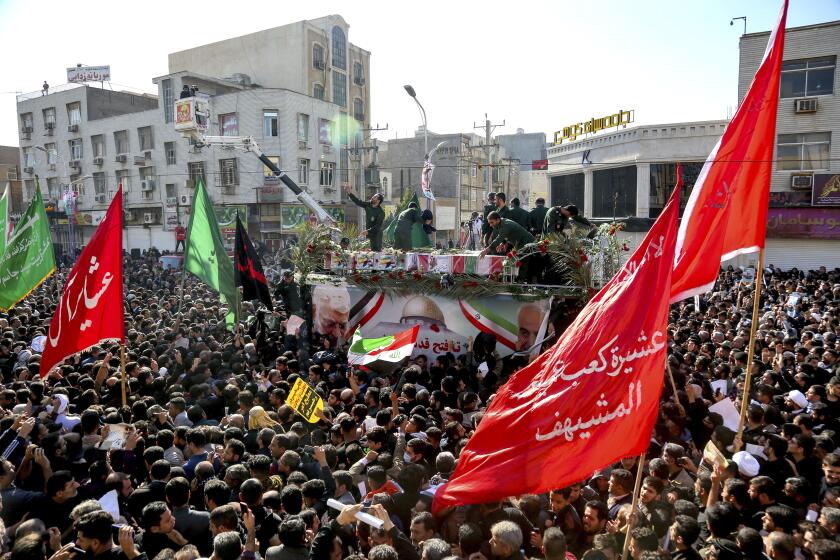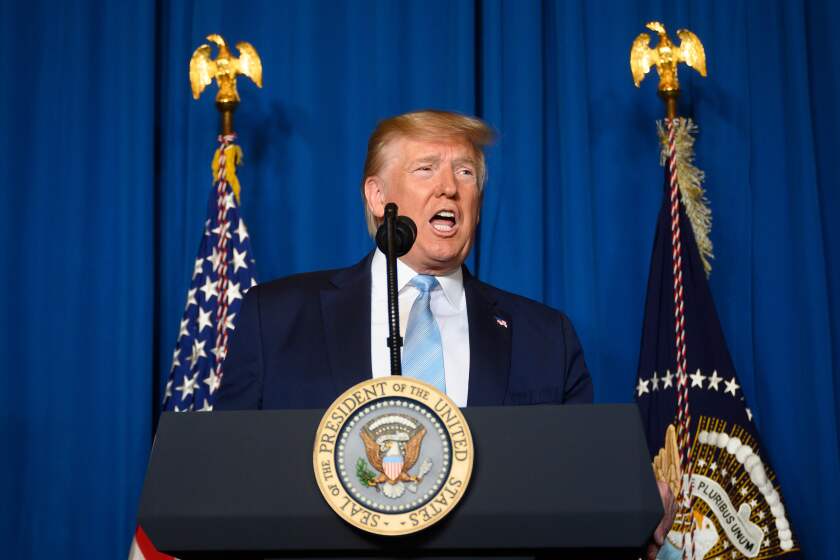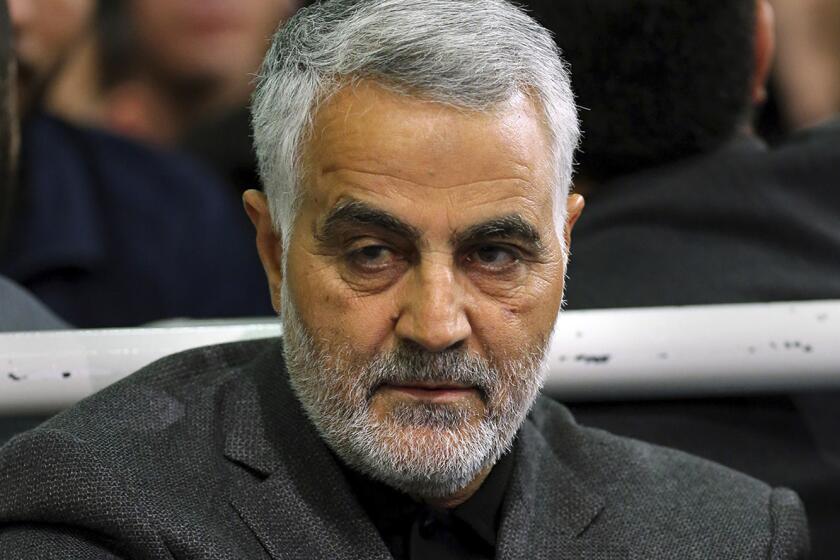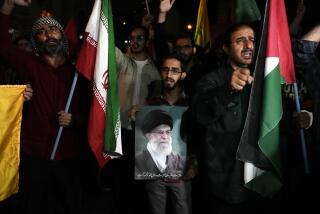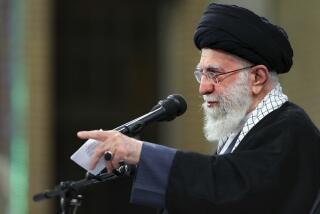Iran won’t abide by nuclear deal limits after U.S. killing of Qassem Suleimani
- Share via
Iran said Sunday it would no longer abide by limits of its unraveling 2015 nuclear deal with world powers after a U.S. airstrike killed a top Iranian general in Baghdad, ending an accord that was meant to block Tehran from having enough material to build an atomic weapon.
The announcement came Sunday night after another Iranian official said it would consider taking harsher steps over the U.S. killing of Gen. Qassem Suleimani on Friday. Hundreds of thousands of people flooded the streets Sunday in Iran to walk alongside a casket carrying the remains of Suleimani, the former leader of its expeditionary Quds Force, which organizes Tehran’s proxy forces in the wider Mideast.
The leader of one such proxy, Lebanon’s Hezbollah, said Suleimani’s killing made U.S. military bases, warships and service members spread across the region fair targets for attacks. A former Revolutionary Guard leader suggested the Israeli city of Haifa and “centers” including Tel Aviv could be targeted.
Iran’s state TV cited a statement by President Hassan Rouhani’s administration saying the country would not observe limitations on its enrichment, the amount of stockpiled enriched uranium, or research and development in its nuclear activities.
It did not elaborate on what levels it would immediately reach in its program.
The International Atomic Energy Agency, the United Nations watchdog observing Iran’s program, did not immediately respond to a request for comment. Iran said, however, that its cooperation with the IAEA would “continue as before.”
Tensions spiral as Iran backs away from nuclear commitments, Iraqi lawmakers vote to eject American troops and the U.S.-led fight against Islamic State is ‘paused’
Meanwhile, Iraq’s parliament voted in favor of a resolution calling for an end to foreign military presence in their nation, an effort aimed at expelling the 5,000 U.S. troops stationed there over the war against the Islamic State group.
Suleimani’s killing has escalated the crisis between Tehran and Washington after months of trading attacks and threats that have put the wider Middle East on edge. The conflict is rooted in President Trump pulling out of Iran’s atomic accord and imposing sanctions that have crippled Iran’s economy.
Iran has promised “harsh revenge” for the U.S. attack, which shocked Iranians across all political lines. Many saw Suleimani as a pillar of the Islamic Republic at a moment when it was beset by U.S. sanctions and recent anti-government protests.
Retaliation for Suleimani’s slaying could potentially come through the proxy forces that he oversaw. Suleimani’s longtime deputy Esmail Ghaani already has taken over as the Quds Force’s commander.
The U.S. Embassy in Saudi Arabia separately warned Americans “of the heightened risk of missile and drone attacks.”
Late Saturday, a series of rockets launched in Baghdad fell inside or near the Green Zone, which houses government offices and foreign embassies, including the U.S. Embassy.
Trump wrote on Twitter afterward that the U.S. had already “targeted 52 Iranian sites (representing the 52 American hostages taken by Iran many years ago), some at a very high level & important to Iran & the Iranian culture.”
Trump did not identify the targets but added that they would be “HIT VERY FAST AND VERY HARD.”
The 1954 Hague Convention, of which the U.S. is a party, bars any military from “direct hostilities against cultural property.” Such sites can be targeted, however, if they have been repurposed and turned into a legitimate “military objective,” according to the International Committee of the Red Cross.
Iran, home to 24 UNESCO World Heritage sites, has in the past reportedly guarded the sprawling tomb complex of the Islamic Republic’s founder, Ayatollah Ruhollah Khomeini, with surface-to-air missiles.
Trump chose to attack Suleimani after military leaders outline Iranian plans, officials say.
After thousands in Baghdad on Saturday mourned Suleimani and others killed in the strike, authorities flew the general’s body to the southwestern Iranian city of Ahvaz. An honor guard stood by early Sunday as mourners carried the flag-draped coffins of Suleimani and other Guard members off the tarmac.
The caskets then moved slowly through streets choked with mourners wearing black, beating their chests and carrying posters with Suleimani’s portrait. Demonstrators also carried red Shiite flags, which traditionally both symbolize the spilled blood of someone unjustly killed and call for their deaths to be avenged.
Officials brought Suleimani’s body to Ahvaz, a city that was a focus of fighting during the bloody 1980-88 war between Iraq and Iran in which the general slowly grew to prominence. After that war, Suleimani joined the Guard’s newly formed Quds (or Jersualem) Force, an expeditionary force that works with Iranian proxy forces in countries such as Iraq, Lebanon and Yemen.
Authorities then took Suleimani’s body to the city of Mashhad later Sunday. State TV estimated that a million mourners came out to the Imam Reza shrine to pay their respects, although that number could not be independently verified. Suleimani’s remains will go to Tehran and Qom on Monday for public mourning processions, followed by his hometown of Kerman for burial Tuesday.
This marks the first time Iran has honored a single man with a multi-city ceremony. Not even Khomeini received such a processional with his death in 1989. Suleimani on Monday will lie in state at Tehran’s famed Musalla mosque as the revolutionary leader did before him.
Suleimani was the architect of Iran’s regional policy of mobilizing militias across Iraq, Syria and Lebanon, including in the war against the Islamic State group. He was also blamed for attacks on U.S. troops and American allies going back decades.
Although it’s unclear how or when Iran may respond, any retaliation was likely to come after the three days of mourning declared in both Iran and Iraq.
Mohsen Rezaei, a former leader of the Guard, told a crowd of mourners in Tehran that the Israeli city of Haifa and other “centers” including Tel Aviv could be targeted. Rezaei earlier alleged without offering evidence that Israel leaked information to the U.S. about Suleimani’s whereabouts, which allowed Americans to carry out the drone strike.
“Rest assured we will level to the ground Haifa and Israeli centers so that Israel will be wiped out,” he said. “The issue is very serious for the Iranian nation. You hit us and you should get hit. You attacked us and it is the Iranian nation’s right.”
An Iranian general was killed in Iraq. Why did Trump want him dead?
Iranian officials planned to meet Sunday night to discuss taking a fifth step away from its 2015 nuclear deal with world powers, one that could be even greater than planned, Foreign Ministry spokesman Abbas Mousavi told journalists.
“In the world of politics, all developments are interconnected,” Mousavi said.
Iran previously has broken limits of its enrichment, its stockpiles and its centrifuges, as well as restarted enrichment at an underground facility.
The Iranian parliament on Sunday opened with lawmakers in unison chanting: “Death to America!” Parliament speaker Ali Larijani compared Suleimani’s killing to the 1953 CIA-backed coup that cemented the shah’s power and to the U.S. Navy’s shoot-down of an Iranian passenger plane in 1988 that killed 290 people. He also described American officials as following “the law of the jungle.”
Rain fell at the shrine in Mashhad late Sunday as an imam delivered a sermon over the coffins of Suleimani and others. The crowd surged and shouted as he preached. Mourners threw clothing up to officials accompanying the remains to have the fabric be brushed against the caskets in a belief it would carry God’s blessings to them.
More to Read
Sign up for Essential California
The most important California stories and recommendations in your inbox every morning.
You may occasionally receive promotional content from the Los Angeles Times.
